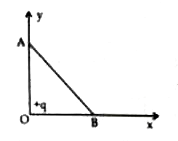As per this diagram a point charge +q is placed at the origin O. Work done in taking another point charge −Q from the point A(0,a) to another point B(a,0) along the staight path AB is:

zero
(−qQ/4πε0)(1/a2)√2a
(qQ/4πε0)(1/a2).a/√2
(qQ/4πε0)(1/a2)√2a
The correct Answer is:A

Work done= Change in potential energy =q(Δv)
Here, Potential at point A and B are same. So, work done is equal to zero.
Topper's Solved these Questions
- ELECTROSTATIC POTENTIAL AND CAPACITANCEBOOK - PHYSICS WALLAHCHAPTER - ELECTROSTATIC POTENTIAL AND CAPACITANCEEXERCISE - LEVEL II
34 Videos
- ELECTROSTATIC POTENTIAL AND CAPACITANCEBOOK - PHYSICS WALLAHCHAPTER - ELECTROSTATIC POTENTIAL AND CAPACITANCEEXERCISE - NEET Past 5 Years Questions
15 Videos
- ELECTROMAGNETIC WAVESBOOK - PHYSICS WALLAHCHAPTER - ELECTROMAGNETIC WAVESEXERCISE - NEET Past 5 Years Questions
8 Videos
- GENERAL PRINCIPLES AND PROCESSES OF ISOLATION OF ELEMENTSBOOK - PHYSICS WALLAHCHAPTER - GENERAL PRINCIPLES AND PROCESSES OF ISOLATION OF ELEMENTSEXERCISE - NEET Past 5 Years Questions
14 Videos
Similar Questions
A point charge q is placed at the origin . How does the electric field due to the charge very with distance r from the origin ?
View SolutionA charge of 8 mC is located at the origin. Calculate the work done in taking a small charge of −2×10−9C from a point P (0,0,3 cm) to a point Q (0,4 cm, 0) via a point R (0,6 cm, 9cm).
View Solution
Knowledge Check
As per this diagram a point charge +q is placed at the origin O. Work done in taking another point charge −Q from the point A(0,a) to another point B(a,0) along the staight path AB is:
 AzeroB(−qQ/4πε0)(1/a2)√2aC(qQ/4πε0)(1/a2).a/√2D(qQ/4πε0)(1/a2)√2a
AzeroB(−qQ/4πε0)(1/a2)√2aC(qQ/4πε0)(1/a2).a/√2D(qQ/4πε0)(1/a2)√2aIn the firgure the charge Q is at the centre of the circle. Work done is maximum when another charge is taken from point P to
 AKBLCMDN
AKBLCMDNA charge +q is placed at the origin O of X- Y axes as shown in the figure . The work done in taking a charge Q from A to B along the straight line AB is
 AqQ4πε0(a−bab)BqQ4πε0(b−aab)CqQ4πε0(ba2−1b)DqQ4πε0(ab2−1b)
AqQ4πε0(a−bab)BqQ4πε0(b−aab)CqQ4πε0(ba2−1b)DqQ4πε0(ab2−1b)
A charge of 8 mC is located at the origin. Calculate the work done in taking a small charge of −2×10−9C from a point P(0,0,3 cm) to a point Q10,4 cm, 0) via a point R(0,6 cm, 9 cm).
View Solution‘A point charge +Q is placed at point O as shown in the figure. Is the potential difference VA–VB positive.

View SolutionA charge of 8 mC is located at the origin. Calculate the work done in taking a small charge of −2×10−9 from a point P(0,0,3cm) to a point Q (0,4cm,0) via a point R(0,6cm,9cm).
View SolutionA point charge of 0.01 μC is placed at the origin. Calculate the electric field at another point charge of 0.05 μC placed at (0 m, 5 m).
View SolutionAs shown in the figure a charge +2 C is situated at the origin O and another charge +5 C is on the x -axis at the point A . The later charge from the point A is then brought to a point Bon the y - axis . The work done is
(given14πε0=9×109)

View Solution
